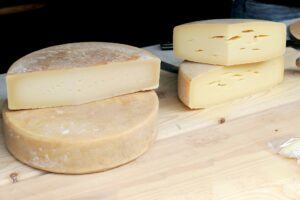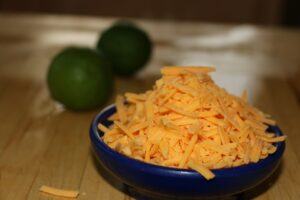Raw Milk Cheese versus Pasteurized Milk Cheese
For more information about cheese ingredients, check out our Ingredients in Cheese post.
If you are interested in making your own cheese at home, check out our instructional post How to Make cheese at Home. You can also check out our favourite cheese recipes on our Cheese Making Recipes page.
We review and suggest cheese making kits and the products you need to make cheese. Visit our Cheese Making Kit and Reviews page for more info.
I get asked frequently why milk is being pasteurized to make cheese? Or what is the difference between cheese made from raw milk and cheese made from pasteurized milk.
Many people are asking out of curiosity, but for some consumers a raw diet is important. They are looking for products with raw ingredients.
The difference really comes down to the cultural background and food safety.
Raw Milk Cheese, or Cheese Made from Raw Milk

Traditionally, all cheese was made from raw milk. Most traditional European cheeses are still made from raw milk today. I say “most” because some cheeses that were made with raw milk are now made with pasteurized milk, especially soft cheeses that require less aging.
Raw milk contains a bunch of bacteria and enzymes. Clean milk dominantly contains a bacteria called “lactobacillus lactis”. This is a very beneficial bacteria for us and also gives the end product a pleasant flavor and taste. This bacteria comes in endless amounts of different strains. The “good” bacteria in raw milk have a huge influence on the development of the cheese. Enzymes help brake down fats and proteins and therefore have an important role in the flavour development. Raw milk has all naturally occurring enzymes present which influences the flavour development significantly. The cheese maker still adds their own cheese typical bacteria cultures, but the bacteria naturally found in the milk will add to the characteristics of the cheese.
With that being said, there is also the possibility for unwanted or even pathogen bacteria in the raw milk. The good news is that all of these unwanted bacteria, especially coliform, which are most likely to be present, don’t accept an acidic environment. Since cheese is a fermented milk product, the low acidity in the finished cheese will kill off coliforms and other pathogens within a few weeks.
Typically, raw milk cheese is aged for 60 days, then tested for coliform before being released into the marketplace. Some countries make this aging time mandatory for public safety reasons. In France, however, there are still soft cheeses like Brie or Camembert produced from raw milk, in North America it is not permitted.
The quality of the cheese depends on the quality of the raw milk. Large amounts of coliform bacteria can definitely have a negative impact on the quality of the cheese. Even if they eventually die off, they can still create unwanted flavor patterns, or create gases that make a cheese look like a sponge. With today’s knowledge the raw milk quality has improved hugely compared to decades ago. It is funny, but making cheese from raw milk should be less of a concern nowadays than ever before. But authorities, especially in North America, have raised concerns about it.
As a consumer, you can fully trust cheese made from raw milk. Raw milk cheese has a richer flavor profile than milk from pasteurized cheese. Raw milk cheese can be aged for a long time, due to the many different strains of bacteria that keep each other in balance. A hard, raw milk cheese barely expires, as long as it can be kept mould free.
Here are a few examples of well known raw milk cheeses available in North America: Swiss Emmental, Swiss Gruyere, Parmesan, Peccorino Romano, Grana Padano, Tilsit, Appenzeller, Dutch Gouda, British Cheddars and many local farmstead produced cheeses. It must be clearly indicated on the label. If you are looking for raw milk cheese, double check the ingredients list.
Pasteurized Milk Cheese or Cheese Made from Pasteurized Milk

The entire cheese making process is the same as raw milk, but in this case the milk is being pasteurized first. This means that the majority of the naturally occurring bacteria from the raw milk are removed. When the cheese maker adds the bacteria cultures, they can develop very fast and undisturbed.
This has advantages, like the cheese making process can be shortened a bit and the cheese will be ready for the marketplace much faster. The cheese also ages much faster but cannot be aged as long as a raw milk cheese. The flavor profile is created by the added bacteria only which makes it more consistent but less bountiful. In general, soft cheeses that require very little aging like Brie, Havarti, and many goat cheeses, are made from pasteurized milk.
There are many traditional European cheeses that are made both with raw and pasteurized milk. They interestingly make 2 very different cheeses, although they have the same name.
One example is Gouda. Dutch Gouda traditionally is made with raw milk, but often it is made with pasteurized milk. Swiss Tilsit is traditionally made with raw milk, but a pasteurized milk version exists as well. Raw milk Tilsit, for instance, is aged for 2 months before being released. Tilsit from pasteurized milk is ready for the consumer after 3 weeks. Tilsit that is made with raw milk, after 12 months, will taste strong but still great. Tilsit made from pasteurized milk with turn bitter after 6 months.
Examples of cheese made from pasteurized milk in North America: Cheddars, Monterey Jack, Colby, Mozzarella, North American Swiss, North American Parmesan, and North American Gouda are all made from pasteurized milk. Pay attention to the ingredients list, it has to be clearly indicated if the cheese was made from raw or pasteurized milk.
Many consumers barely pay attention to whether cheese is made from raw or pasteurized milk. Most of us just have our favourite cheeses. There is no ultimate advantage of one over the other. In our time where food is more and more processed industrially, pasteurizing milk is becoming a requirement. This again leaves room for smaller artisan cheese makers to come up with products that differentiate themselves from the mass production.
Please let me know if you prefer cheeses from pasteurized or from raw milk, I am curious to hear from you. Do you have access to local raw milk cheese?
Donat


Hey Donat, thank you for explaining so much about cheese and the ways they are made.
I find it just so amazing the number of different varieties of cheese there are throughout the world.
French being, one if not the biggest makers of cheese, but noticed in the last decade that the UK has been producing some very good cheeses. Now we can enjoy cheese made on our doorstep.
I spent some time in Switzerland and one thing I do remember is their cheeses.
Strange to notice that raw milk in North America is not allowed.
Thanks for sharing, I really enjoyed the post.
Mick
Thank you Mick, I appreciate your feedback!